Rare Earths – China’s six-month export restriction on rare earth metals to the US stirs trade discussions on both sides.

China’s Strategic Rare Earth Export Restriction
China’s announcement to enforce a six-month limit on rare earth export licenses to US automakers and manufacturers is a strategic economic and geopolitical move. Rare earth elements, critical for the production of electric vehicles, advanced military technology, and sustainable energy solutions, have become a crucial bargaining chip in the escalating trade rivalry between the world’s two largest economies. The decision illustrates the leverage China holds as the world’s leading producer of these essential resources. According to reports from The Wall Street Journal, this temporary restriction coincides with high-stakes trade talks aimed at fostering compromise and averting a potentially damaging trade conflict. It highlights the sensitive interplay between the rare earth trade and broader economic diplomacy.
The US Response: Temporary Concessions and Strategic Adjustments
In response to Beijing’s restrictions, US policymakers have reportedly agreed to relax recent export restrictions on jet engines, related components, and chemical products like ethane. These concessions signify a mutual acknowledgment of the importance of maintaining a balanced trade relationship, if only temporarily. US President Donald Trump’s assertive social media post, “ANY NECESSARY RARE EARTHS, WILL BE SUPPLIED, UP FRONT, BY CHINA,” further underscores the pressing need to ensure a steady supply of these critical materials for American industries. While these concessions may ease tensions in the short term, they also underline the fragile nature of US-China economic relations and the ongoing competition over technological and industrial supremacy.
The Broader Implications for Global Trade
The limited timeframe of China’s export restriction serves as a reminder of how precarious global supply chains can be when political interests intersect with economic needs. Rare earths are indispensable not only to US industries but also to global technological advancement. By imposing time-bound restrictions, China sends a clear signal about its willingness to leverage its dominant position in the rare earths market. Simultaneously, the US’s decision to relax export regulations for jet engine components and ethane implies a strategic recalibration to prevent further escalation. This tentative reprieve, while pivotal, reflects the underlying uncertainty in global trade dynamics.
Future Outlook: Navigating the Thin Line Between Collaboration and Competition
As trade talks unfold, both nations are evidently retaining tools to re-escalate tensions as needed. This means that the agreed framework remains vulnerable to external and internal pressures. The emphasis on cooperation, albeit temporary, is a step towards stabilizing the economic relationship between the two global superpowers. However, as each side vies for technological and economic dominance, the potential for renewed friction looms large. In the coming months, businesses and governments alike will be closely watching developments to gauge the long-term implications of these rare earth export policies.
In conclusion, the imposition of a six-month limit on rare earth export licenses by China and the subsequent concessions by the US mark a critical juncture in global trade relations. It emphasizes the growing interdependence between the two economies while also highlighting their competing interests. As these policies evolve, the world will continue to witness the intricate and high-stakes nature of US-China economic diplomacy.
Commentary
The Strategic Importance of Rare Earths
China’s decision to impose a six-month restriction on rare earth exports to the United States highlights the strategic importance of these critical materials in modern geopolitics. Rare earths are vital for producing everything from electric vehicles to advanced military equipment, underscoring their influence in the global industrial landscape. By asserting control over these exports, China has effectively reminded the world of its dominant position in the rare earths market, a move that echoes its broader ambition to leverage economic power strategically. This policy decision is not merely about economics; it is a calculated statement about power dynamics in international trade.
The Fragile Nature of US-China Trade Ties
The rare earth export restriction has exposed the underlying fragility of US-China economic relations. Both countries are deeply interdependent, yet their relationship is fraught with competition and mistrust. While the recent concessions from the US—such as relaxing restrictions on jet engine components and ethane—may ease tensions in the short term, they highlight a precarious balance. Each nation continues to pursue its strategic interests, leading to a scenario where cooperation and competition coexist uneasily. As the global economy pivots towards advanced technologies, this dynamic will likely become a recurring theme in US-China relations.
Lessons for the Global Community
The events surrounding this six-month restriction also present important lessons for other nations and industries. Diversifying supply chains and reducing dependence on any single nation for critical resources have become urgent priorities. The global reliance on China’s rare earths underscores a vulnerability that could disrupt industries worldwide. For the US, this serves as a wake-up call to explore domestic rare earth production and alternative supply sources. For other nations, it is a reminder to strategically rethink supply chain dependencies to mitigate risks associated with geopolitical uncertainties.
Ultimately, the rare earth export restriction is more than a trade policy; it is a critical moment in the evolving story of globalization. As countries navigate the complexities of economic interdependence and national security, the decisions made today will shape the trajectory of global trade and technology for years to come.


